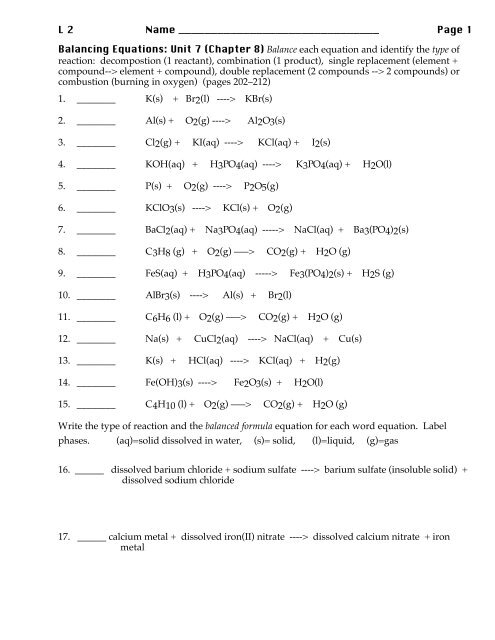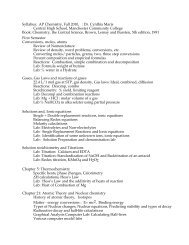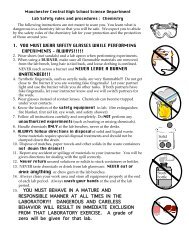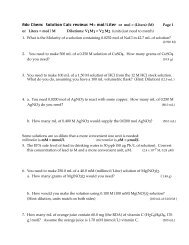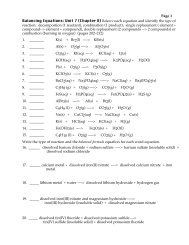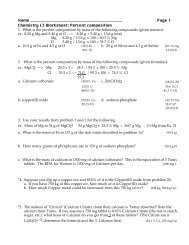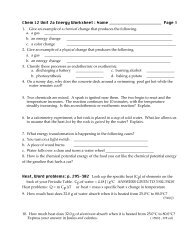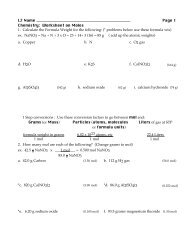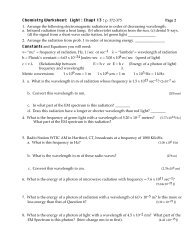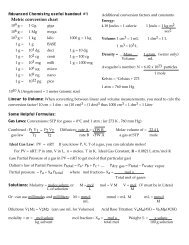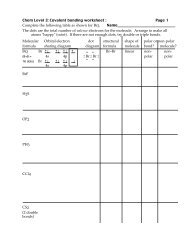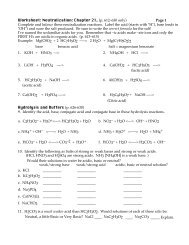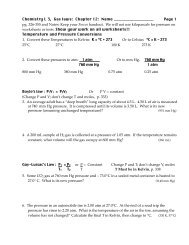Worksheet Balancing Equations
Worksheet Balancing Equations
Worksheet Balancing Equations
Create successful ePaper yourself
Turn your PDF publications into a flip-book with our unique Google optimized e-Paper software.
L 2 Name _______________________________ Page 1<br />
<strong>Balancing</strong> <strong>Equations</strong>: Unit 7 (Chapter 8) Balance each equation and identify the type of<br />
reaction: decompostion (1 reactant), combination (1 product), single replacement (element +<br />
compound--> element + compound), double replacement (2 compounds --> 2 compounds) or<br />
combustion (burning in oxygen) (pages 202–212)<br />
1. ________ K(s) + Br2(l) ----> KBr(s)<br />
2. ________ Al(s) + O2(g) ----> Al2O3(s)<br />
3. ________ Cl2(g) + KI(aq) ----> KCl(aq) + I2(s)<br />
4. ________ KOH(aq) + H3PO4(aq) ----> K3PO4(aq) + H2O(l)<br />
5. ________ P(s) + O2(g) ----> P2O5(g)<br />
6. ________ KClO3(s) ----> KCl(s) + O2(g)<br />
7. ________ BaCl2(aq) + Na3PO4(aq) -----> NaCl(aq) + Ba3(PO4)2(s)<br />
8. ________ C3H8 (g) + O2(g) –––> CO2(g) + H2O (g)<br />
9. ________ FeS(aq) + H3PO4(aq) -----> Fe3(PO4)2(s) + H2S (g)<br />
10. ________ AlBr3(s) ----> Al(s) + Br2(l)<br />
11. ________ C6H6 (l) + O2(g) –––> CO2(g) + H2O (g)<br />
12. ________ Na(s) + CuCl2(aq) ----> NaCl(aq) + Cu(s)<br />
13. ________ K(s) + HCl(aq) ----> KCl(aq) + H2(g)<br />
14. ________ Fe(OH)3(s) ----> Fe2O3(s) + H2O(l)<br />
15. ________ C4H10 (l) + O2(g) –––> CO2(g) + H2O (g)<br />
Write the type of reaction and the balanced formula equation for each word equation. Label<br />
phases. (aq)=solid dissolved in water, (s)= solid, (l)=liquid, (g)=gas<br />
16. ______ dissolved barium chloride + sodium sulfate ----> barium sulfate (insoluble solid) +<br />
dissolved sodium chloride<br />
17. ______ calcium metal + dissolved iron(II) nitrate ----> dissolved calcium nitrate + iron<br />
metal
Page 2<br />
18. _____ lithium metal + water ----> dissolved lithium hydroxide + hydrogen gas<br />
19. _____ dissolved iron(III) nitrate and magnesium hydroxide ----><br />
iron(III) hydroxide (insoluble solid) + dissolved magnesium nitrate<br />
20. _____ dissolved tin(IV) fluoride + dissolved potassium sulfide ---><br />
tin(IV) sulfide (insoluble solid) + dissolved potassium fluoride<br />
21. _____ solid sulfur + oxygen gas ----> sufur trioxide gas<br />
Predict the products (Correct formulas!!) and balance the following reactions.<br />
Combination reactions: Make the binary ionic compound from the elements. (p.212-214)<br />
Example: For K + O2 ––––> answer is 4 K + O2 ––––> 2 K2O (K + O –2 )<br />
22. Al + Br2 -----> 23. Na + O2 ----><br />
Decomposition reactions: Decompose into elements when electricity is added. (p. 214 -216)<br />
Example: NaF –––> answer is 2 NaF –––> 2 Na + F2 (F2 is diatomic)<br />
electricity<br />
elect.<br />
24. HF --------------> 25. MgO ---––-><br />
Complete combustion of a hydrocarbon: O2 gas is a reactant, Products are CO2, H2O<br />
Ex: Complete Combustion of C6H6: Answer: 2 C6H6 + 15 O2 –––> 12 CO2 + 6 H2O (220-222)<br />
26. Complete combustion of C8H18<br />
27. Complete combustion of CH3OH<br />
Incomplete combustion of a hydrocarbon: O2 gas is a reactant, Products are CO, H2O<br />
Ex: Incomplete Combustion of C6H6: Ans: 2 C6H6 + 9 O2 –––> 12 CO + 6 H2O<br />
28. Incomplete combustion of C4H10
L2 Name _____________________________ page 3<br />
29. Incomplete combustion of C3H6<br />
Predicting Single replacement : (Element + compound––> element + compound,<br />
Use the Activity Series: Reacts if the element alone is more active than [above] the element in the<br />
compound. Complete and Balance only if it is a yes! (p. 216-218)<br />
30. HCl(aq) + K(s) ----><br />
31. Cu(s) + NaCl(aq) ----><br />
32. Al(s) + Pb(NO3)2(aq) ----><br />
33. AgNO3(aq) + Mg(s) ----><br />
34. Li(s) + H2O(l) –––><br />
(Halogens) special case !!!!!<br />
35. Cl2(g) + NaBr(aq) –––><br />
36. Br2(l) + KF (aq) –––><br />
37. MgI2(aq) + F2 (g) –––><br />
Predict the products, balance: Double replacement :(2 compounds–>2 compounds,<br />
Use Solubility Chart: Only Reacts IF one product is an Insoluble solid, water or a gas)<br />
(p. 218-220)<br />
1. CaI2(aq) + AgNO3(aq) -----><br />
2. Sr(NO3)2(aq) + Al2(SO4)3(aq) -----><br />
3. KNO3(aq) + NaCl(aq) ---->
Page 4<br />
4. Na2CO3(aq) + CaCl2(aq) ----><br />
5. H2SO4(aq) + Mg(OH)2(aq) -----><br />
6. BaCl2(aq) + Na3PO4(aq) -----><br />
Chemistry : Final worksheet for balancing equations<br />
Identify the type of each reaction (SR, DR, combo, decomp, combustion) Then, balance them.<br />
1. ________ Fe(s) + O2(g) ----> Fe2O3(s)<br />
2. ________ Zn(s) + AgNO3(aq) ----> Zn(NO3)2(aq) + Ag(s)<br />
3. ________ HCl(aq) + Ca(OH)2(s) ----> CaCl2(aq) + H2O(l)<br />
4. ________ SrCl2(aq) + Na3PO4(aq) -----> Sr3(PO4)2(s) + NaCl(aq)<br />
5. ________ C6H12O6(s) + O2(g) –––> CO2(g) + H2O (g)<br />
6. ________ NaCl (l) ----> Na(l) + Cl2(g)<br />
7. ________ Br2(l) + NaI(aq) ----> NaBr(aq) + I2(s)<br />
8. ________ FeCl3(aq) + Ca(OH)2(aq) ----> Fe(OH)3(s) + CaCl2(aq)<br />
9. ________ AlCl3(s) ----> Al(s) + Cl2(g)<br />
10. ________ C6H14 (l) + O2(g) –––> CO2(g) + H2O(g)<br />
11. _______ Cu(s) + Al(NO3)3(aq) ----> Cu(NO3)2(aq) + Al(s)<br />
12. _______ H2SO4(aq) + Al(OH)3(aq) ----> Al2(SO4)3(aq) + H2O(l)<br />
13. DR + Decomp MgCO3(aq) + HNO3(aq) ----> Mg(NO3)2(aq) + H2O(l) + CO2(g)<br />
14. _______ Pb(NO3)2(s) ----> PbO(s) + NO2(g) + O2(g)<br />
Write the type of reaction and the balanced formula equation for each word equation.<br />
Label phases<br />
15. _______ solid phosphorus + oxygen gas ----> solid diphosphorus pentoxide<br />
16. _______ copper metal + chlorine gas ---> solid copper(I) chloride
L 2 Name _______________________________ Page 5<br />
17. _______ zinc metal + iron(II) nitrate ---> iron metal + zinc nitrate<br />
18. _______ dissolved sodium phosphate and barium chloride ---> dissolved sodium chloride +<br />
Insoluble solid Barium phosphate<br />
19. _______ potassium metal + water ---> dissolved potassium hydroxide + hydrogen gas<br />
20. _______ solid magnesium oxide plus water ---> dissolved magnesium hydroxide<br />
Predict the Products and Balance: In addition, for the SR and DR, list the type of<br />
reaction and tell WHY it reacts or doesn't react. (p. 222-224)<br />
Type<br />
Reason<br />
21. ______ K2CO3(aq) + Ca(NO3)2(aq) ----><br />
22. ______ Mg(s) + AgNO3(aq) ---><br />
23. ______ Ca(OH)2(s) + HCl(aq) ----><br />
24.Combination Na(s) + Br2(l) –––><br />
25. ______ KNO3(aq) + MgSO4(aq) -----><br />
26. ______ Pb(s) + MgI2(aq) -----><br />
27. Complete combustion: C5H10 + –––><br />
28. ______ Al(s) + H2SO4(aq) ----><br />
electricity<br />
29. Decomp KI ––––––––><br />
30. ______ Na(s) + H2O(l) –––><br />
31. ______ Na3PO4(aq) + MgBr2(aq) ---><br />
32. ______ FeCl2(aq) + Na(s) --->


